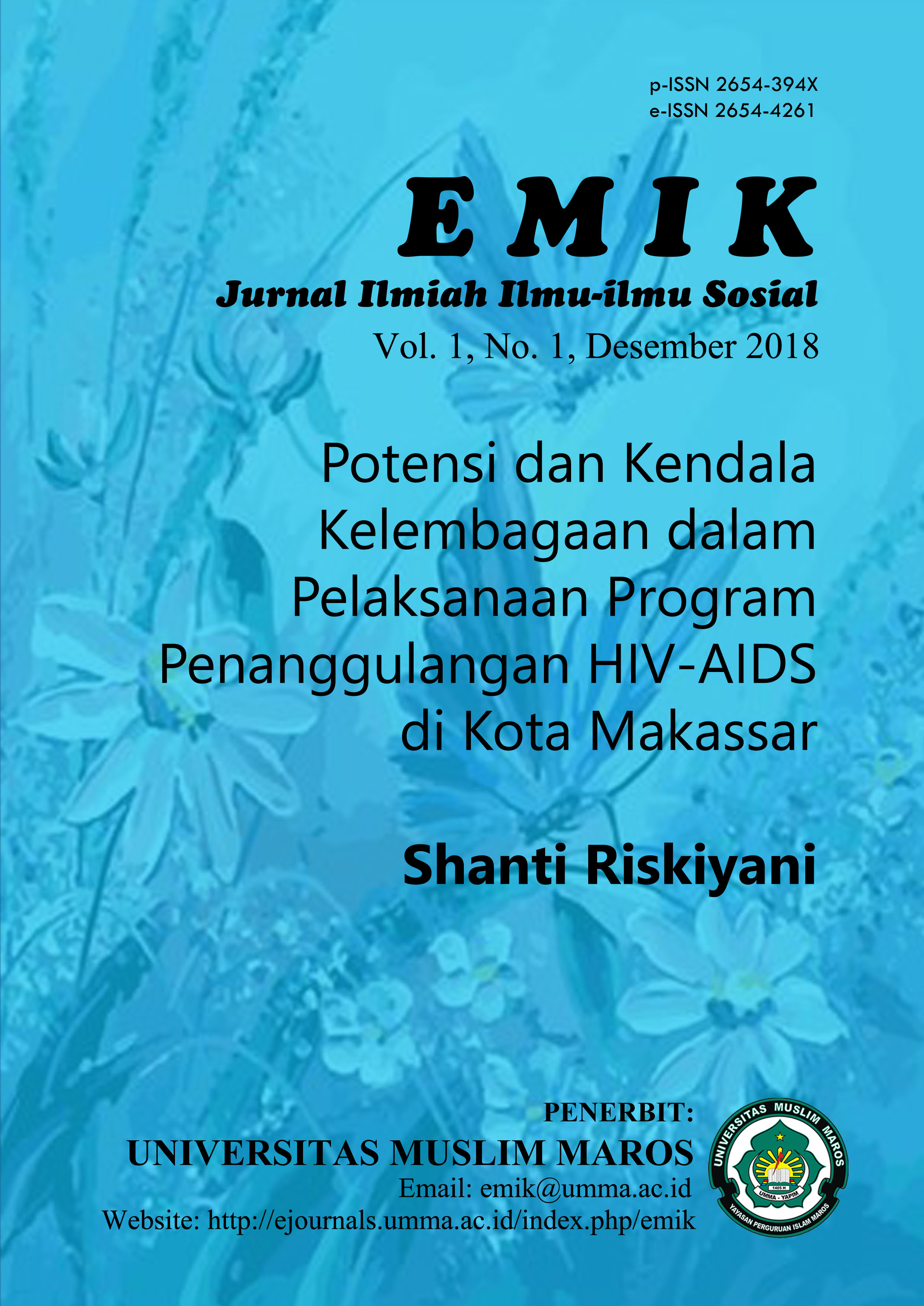Potensi dan Kendala Kelembagaan dalam Pelaksanaan Program Penanggulangan HIV-AIDS di Kota Makassar
Abstract
HIV-AIDS program in Indonesia until now cannot be separated from global health initiatives carried out through various program and funding schemes. Although the financing of these global initiatives tends to decline over the years, funding for HIV-AIDS program still depends on bilateral and multilateral grants. This article examines institutional potency and constraints in the implementation of the HIV-AIDS prevention program in Makassar. Data was collected using in depth-interviews with five stakeholders and also a focus group discussion with twelve participants represented their institution as service providers and some beneficiaries. The study shows that the process of drafting local regulation (Perda) also involved NGOs and community organizations, particularly those engaged in the issue of HIV-AIDS in South Sulawesi. However, the existence of this regulation needs to be supported by technical policies at the regional level. Provincial AIDS Commission as a non-structural institution had poor power to encourage other instition under provincial government. Central government and donors still the main funding for the program. A financing support from local government is more on prevention activities. Furthermore, in some non-health institutions, they “wrap-up” HIV-AIDS issues with other activities that connected to their core business. According to their main task and function, HIV issues is not part of their business, so financial support for this activity should not be shown on their program. Several primary health cares in Makassar already had a service for HIV-AIDS program. Public health services were a routine program for health institution, while non-health institutions only involved in prevention activities and is only implemented occasionally as a part of national health ceremony. Other activities for HIV-AIDS program is implemented by NGOs through outreach program and community support. Meanwhile, the program still lacks of well-trained and skillful human resources since most of related training is held by central government, and this creates regional dependence on the central government. The strength of personalization in HIV program in Makassar is a leverage for the success of the program. Those who care about people living with HIV, will had a maximum effort in their job. However, this can be a “double-edged knife” if the those person is no longer working on a HIV program.
References
Atun R.; de Jongh T.; Secci F.; dan Ohiri K., A. O. 2010. “Integration of Targeted Health Interventions into Health Systems: A Conceptual Framework for Analysis”. Health Policy and Planning 25(2):104-111.
Cash-Gibson, L. dan Rosenmoller, M. 2014. “Project Integrate-A Common Methodological Approach to Understand Integrated Health Care in Europe”. International Journal of Integrated Care, October-December:1-11.
Coker, R.; Balen, J.; Mounier, S.; Shigayeva, A.; Lazarus, J.; Rudge, J.; Naik, N. dan Atun, R. 2010. “A Conceptual and Analytical Approach to Comparative Analysis of Country Case Studies: HIV and TB Control Programmes and Health Systems Integration”. Health Policy and Planning, 25(1):i21–i31.
Conseil, A.; Mounier-Jack, S.; dan Coker, R. 2010. “Integration of Health Systems and Priority Health Interventions: a Case Study of the Integration of HIV and TB Control Programmes into the General Health System in Vietnam”. Health Policy and Planning 25(1): i32–i36.
Desai, M.; Adisasmito, R.J.W., Mounier-Jack, S.; dan Coker, R. 2010. “Critical Interactions between Global Fund-Supported Programmes and Health Systems: a Case Study in Indonesia”. Health Policy and Planning, 25(1):i43–i47.
Ford, N.; Siregar, N.; Ngatimin, R. dan Maidin, A. 1997. “The Hidden Dimension: Sexuality and Responding to Threat of HIV/AIDS in South Sulawesi”. Health and Place, 3(i4): 249-258.
Green, J., dan Thorogood, N. 2009. Qualitative Methods in Health Research. USA: Sage Publications.
Grepin, A. K. dan Michael R.R. 2008. “Conceptualizing Integration: A Framework for Analysis Applied to Neglacted Tropical Disease Control Partnership”. PLOS Neglated Tropical Disease, 2(4):1-4.
Kawonga, M.; Blaauw, D.; dan Fonn, S. 2012. “Aligning Vertical Interventions to Health System: A Case Study of HIV Monitoring and Evaluationa System in South Africa”. Health Research Policy and System, 10(20):1-13.
Kawonga, M.; Fonn, S.; dan Blaauw, D. 2013. “Administrative of Vertical Monitoring and Evaluation in to Health Study; Case Study in South Africa”. Global Health Action, 6(10):157-168.
Nasir, S. dan Rosenthal. D. 2009. “The Social Context of Initiation Into Injecting Drugs in the Slums of Makassar, Indonesia”. International Journal of Drug Policy, 20(3): 237-243.
Shigayeva, A.; Atun, R.; McKee, R. dan Coker, R. 2010. “Health Systems, Communicable Diseases and Integration”. Health Policy and Planning, 25(1):i4–i2.
Tribun Timur. 2014. “Setiap Hari Ada 2-3 Kasus Baru HIV Ditemukan di Sulawesi Selatan”. Rubrik Kesehatan Sulawesi Selatan, 23 Juni.




